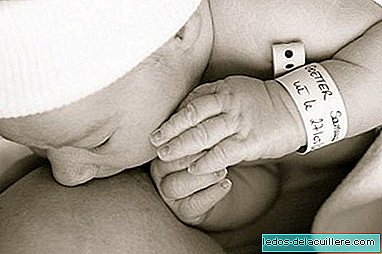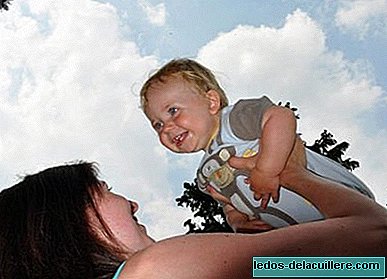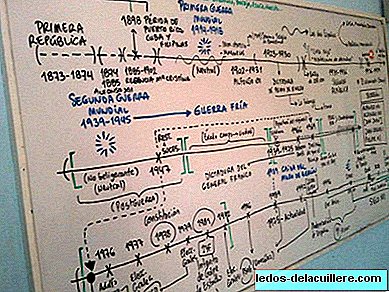
A few weeks ago we explained why some babies do not achieve a good grip on the chest, the most common causes being the lack of skin-to-skin contact at birth, which would allow the first take to be carried out before separating the baby from his mother , sedation in the baby secondary to the administration of medication in the mother during childbirth and the administration of a bottle or pacifier the first few days that could cause confusion in the baby.
Whatever the cause, once the baby is poorly grasped it can be difficult to correct the position and it usually happens that the mother has cracks, which are usually very painful, that the baby does not suck well and does not get enough milk , that he even cries of hunger and that the mother also ends up crying in pain, seeing her son crying and realizing that not enjoying something that should be precious (I have put myself in the worst case, which does not always happen, but that is common ... some babies get fat without complaining too much and yet the mother suffers pain from a bad position).
When this happens there is a technique that is used a lot and that I love, because it is not carried out by the professional, nor the mother, but the baby, which is known as spontaneous consolidation and that is the way to say to the baby: "Breast calmly, slowly, calmly, and do it as only you know."
Babies are born knowing how to breastfeed
Babies are born knowing how to suck perfectly. So much so that they are not only able to open their mouths and suck to get their food, but they have the ability to crawl and move over their mother's abdomen and chest to reach the nipple, guided mostly by the smell and a little because of the dark color that contrasts with the rest of the skin (for that the nipples are darkened during pregnancy).
A picture is worth a thousand words, so watch this video and you will understand:
Well, that instinct of suction with which they come equipped lasts about 3 or 4 months, time that can be used if at any time something has been done wrong and the baby has learned to breastfeed in any other way for whatever reason.
Breastfeeding problems appear
Let's say someone put a pacifier or a bottle, or a catheter through the mouth and the baby learned that what goes through the mouth is not as expected, changing the way you suck. Let's say that he was simply so long separated from his mother that he fell asleep and it took him enough time to suck enough to make a different grip than expected, learning to do it wrong from the beginning.
Cracks come, pain, physical and emotional discomfort, lack of confidence in oneself, doubts, advice from everyone that far from helping become irritable spears that the mother does not want to hear and even that time comes in which the mother begins to hate the clock because she sees the time for breastfeeding.
The solutions appear
Then, solutions such as supplements, teat cups, artificial milk or weaning begin to appear and along with them the comments of support and rejection before each new decision.
In this wave of ideas that may or may not work appears a little used (increasingly, especially in support groups) that surprises because, as I said, it is not carried out by the professional or the advisor, not even the mother. It is the baby who gives the solution: spontaneous consolidation.
The technique of non-technical (TNT)
Three years ago, when I did the breastfeeding consultants course, they explained to us the technique of spontaneous consolidation with great enthusiasm, since it was something very unknown in our country that was beginning to be used in support groups.

They showed us videos and explained what it was about and everyone who was there stayed punctual (or grimy), seeing babies whose mothers had almost thrown in the towel (or had already thrown it away) suddenly taking to the chest and sucking as if they had always done.
At that time he was called the technique of non-technical (TNT), because it was a method in which, for the first time, nobody had to do anything. Out hands, nothing to touch the baby, or his head, or his lips to open, or put it like that or put it handle. The baby just before the breast of his mother invited to breastfeed. The most amazing? Than works.
Time later the name changed to spontaneous consolidation, more technical and defining than the previous one and thus it is still known today.
What is spontaneous consolidation
He spontaneous consolidation It consists of telling the baby, with our actions, that he can return to his origins. Let him forget what he has learned from the time he has been outside and that we are very sorry, but we have not been able to teach him well, so it must be he who takes the reins and takes his chest as he already knew at birth. I usually tell mothers that it is like doing a “Reset” to what the baby has learned about breastfeeding to say “start over”.
To return to the more mammalian instincts of the baby it is necessary to act as such, so the ideal is that mom take off her clothes from the waist up and take her baby off too (leaving the diaper, which is also not a plan to take unnecessary risks).
Mom feel comfortable inclined about 45º (semi-sitting position) and the baby is placed on his stomach, just as the mothers of premature babies perform the Mother Kangaroo Method.
It must be done at a time when the baby is not hungry, because if so it will not work.
In that position, the mother should almost forget the objective and simply dedicate herself to enjoying contact with her baby. Caress him, whisper ... love him.
After a while, maybe ten minutes, maybe an hour, the baby begins to feel hungry and aware of the position he is in will begin to move in search of the chest. While in the center he has two to choose from, so he himself will drop to one of them. This is the only moment in which the mother must intervene actively, not to guide him, but simply to prevent the baby from falling, stopping him with his arms.
Then the baby will begin to make movements with his body and legs to slide through his mother's body in search of the nipple.

Little by little it will reach him and that is when he starts to move his head to bring his mouth to his mother's chest. He will nod, fail, open his mouth and try to suck areas that are not. You might even use your hands to try to prepare your chest in the right direction. Finally, it will point the mouth towards the nipple and flas! (I didn't know what onomatopoeia to use), The baby will be sucking well at the perplexity of his mother.
He is not a mathematician, he has no guaranteed success, but it does work on many occasions. Thanks to this specific shot in which the baby learns to breastfeed again, the rest of the shots will be more satisfactory.
Of course it does not have to be done in each shot, because the baby learns to suck well again, but it can be useful for the mother to place it more or less in the same way: sitting at 45º, the baby on the belly already oriented to the chest and leave a few minutes or seconds for him to catch.
Once the shot is correct, cushions can be used to “fix” the baby, but not before, because they limit the freedom of positions.
Will you always suck well?
Well, to know. The good thing about this technique is that it can be done as many times as you want. There are mothers who explain that after a while the baby begins to catch some vices and breastfeed a little worse. In these cases it is recommended to perform the technique of spontaneous strengthening again (in the same way that we press the "reset" of the computer every time we believe it is necessary).
How old can it be?
As we have already said, babies have a strong instinct for sucking at birth that they gradually lose. It is difficult to put figures to something like that, but it seems that there is some consensus in stating that By 3-4 months, babies lose their ability to suck well.
There are cases of mothers who give bottles to babies of two and three months, almost from birth, who have achieved a correct grip thanks to this technique, but it cannot be said that it will always happen, much less.
In such cases there is only one recommendation: try it. Nothing is lost and the worst thing that can happen is that you have a good time enjoying contact with your baby, which is not little.
Photos | Raphael Goetter, moppet65535, Daquella way on Flickr
Video | Youtube
In Babies and more | Why many children do not take well to the chest, Crawling to breastfeed, a video about the power of the human instinct, The V Spanish Congress of Breastfeeding in detail












